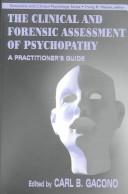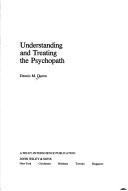| Listing 1 - 10 of 135 | << page >> |
Sort by
|

ISBN: 0805830383 Year: 2000 Publisher: Mahwah (N.J.) Erlbaum
Abstract | Keywords | Export | Availability | Bookmark
 Loading...
Loading...Choose an application
- Reference Manager
- EndNote
- RefWorks (Direct export to RefWorks)
Antisocial personality disorders --- Antisocial personality disorders. --- Diagnosis.
Book
ISBN: 1911623893 9781911623892 9781911623984 1911623982 1009234463 1009234471 Year: 2022 Publisher: Cambridge, United Kingdom ; New York, NY Cambridge University Press
Abstract | Keywords | Export | Availability | Bookmark
 Loading...
Loading...Choose an application
- Reference Manager
- EndNote
- RefWorks (Direct export to RefWorks)
"In this book the authors explore current issues in the conceptualisation, assessment and treatment of antisocial personality. Consideration of two related constructs, psychopathy and sociopathy, is unavoidable given overlap in their meanings. The New Oxford Dictionary of English offers the following definition of 'antisocial': contrary to the laws and customs of society; causing annoyance and disapproval in others, e.g., aggressive and antisocial behaviour [1]. A person with antisocial personality is therefore one who both acts unlawfully or contrary to social norms and customs, and behaves in ways that others find objectionable. The dictionary defines a 'sociopath' as one with a personality disorder manifesting itself in extreme antisocial attitudes and behaviour.1 A 'psychopath' is defined as a person suffering from chronic mental disorder with abnormal or violent social behaviour. This latter definition perhaps reflects the common (layperson's) perception of the 'psychopath' as someone who is dangerous and mentally deranged. Implicit in these definitions is the idea that there exists a continuum of antisocial behaviour or 'antisociality', ranging from the obnoxious but relatively benign, through the more severe and disordered (sociopathy) to the extreme (psychopathy) characterised by abnormal or violent social behaviour. This idea of an antisociality continuum is reflected in contemporary usage of these terms"--
Antisocial personality disorders. --- Antisocial personality disorders --- Treatment.

ISBN: 0471836508 Year: 1987 Publisher: New York
Abstract | Keywords | Export | Availability | Bookmark
 Loading...
Loading...Choose an application
- Reference Manager
- EndNote
- RefWorks (Direct export to RefWorks)
Book
ISBN: 0876301723 9780876301722 Year: 1978 Publisher: New York (N.Y.): Brunner and Mazel,
Abstract | Keywords | Export | Availability | Bookmark
 Loading...
Loading...Choose an application
- Reference Manager
- EndNote
- RefWorks (Direct export to RefWorks)
Book
Abstract | Keywords | Export | Availability | Bookmark
 Loading...
Loading...Choose an application
- Reference Manager
- EndNote
- RefWorks (Direct export to RefWorks)

ISBN: 076791581X Year: 2005 Publisher: New York : Broadway Books,
Abstract | Keywords | Export | Availability | Bookmark
 Loading...
Loading...Choose an application
- Reference Manager
- EndNote
- RefWorks (Direct export to RefWorks)
Who is the devil 'you' know? Is it your lying, cheating ex-husband? Your sadistic high school gym teacher? Your boss who loves to humiliate people in meetings? The colleague who stole your idea and passed it off as her own? In the pages of 'The Sociopath Next Door', you will realize that your ex was not just misunderstood. He's a sociopath. And your boss, teacher, and colleague? They may be sociopaths too. We are accustomed to think of sociopaths as violent criminals, but in 'The Sociopath Next Door', Harvard psychologist Martha Stout reveals that a shocking 4 percent of ordinary people& one in twenty-five& has an often undetected mental disorder, the chief symptom of which is that that person possesses no conscience. He or she has no ability whatsoever to feel shame, guilt, or remorse. One in twenty-five everyday Americans, therefore, is secretly a sociopath. They could be your colleague, your neighbor, even family. And they can do literally anything at all and feel absolutely no guilt. ' ' How do we recognize the remorseless? One of their chief characteristics is a kind of glow or charisma that makes sociopaths more charming or interesting than the other people around them. They're more spontaneous, more intense, more complex, or even sexier than everyone else, making them tricky to identify and leaving us easily seduced. Fundamentally, sociopaths are different because they cannot love. Sociopaths learn early on to show sham emotion, but underneath they are indifferent to others' suffering. They live to dominate and thrill to win. The fact is, we all almost certainly know at least one or more sociopaths already. Part of the urgency in reading 'The Sociopath Next Door' is the moment when we suddenly recognize that someone we know& someone we worked for, or were involved with, or voted for& is a sociopath. But what do we do with that knowledge? To arm us against the sociopath, Dr. Stout teaches us to question authority, suspect flattery, and beware the pity play.
Book
ISBN: 1462535143 146253516X 9781462535163 9781462535132 1462535135 Year: 2018 Publisher: New York
Abstract | Keywords | Export | Availability | Bookmark
 Loading...
Loading...Choose an application
- Reference Manager
- EndNote
- RefWorks (Direct export to RefWorks)
Book
ISBN: 1536129550 Year: 2017 Publisher: New York : Nova Science Publishers,
Abstract | Keywords | Export | Availability | Bookmark
 Loading...
Loading...Choose an application
- Reference Manager
- EndNote
- RefWorks (Direct export to RefWorks)
Book
ISBN: 128023752X 140515442X 9786610237524 1405148772 Year: 2005 Publisher: Malden, MA : Blackwell Pub.,
Abstract | Keywords | Export | Availability | Bookmark
 Loading...
Loading...Choose an application
- Reference Manager
- EndNote
- RefWorks (Direct export to RefWorks)
The bool will provide a detalied summary of the field of psychopathy and antisocial behaviour. Some of the more striking results from the social psychology of antosocial behaviour will be considered. However the books main goal is to provide a neuro-cognitive account of the disorder.
Book
ISBN: 1634503880 Year: 2016 Publisher: New York, NY : Skyhorse Publishing,
Abstract | Keywords | Export | Availability | Bookmark
 Loading...
Loading...Choose an application
- Reference Manager
- EndNote
- RefWorks (Direct export to RefWorks)
| Listing 1 - 10 of 135 | << page >> |
Sort by
|

 Search
Search Feedback
Feedback About UniCat
About UniCat  Help
Help News
News